Table of Contents
- Use Chain-of-Thought Prompting for Complex Problem Solving
- Create Custom Command Shortcuts for Repetitive Tasks
- Master Multimodal Prompting for Enhanced Visual Analysis
- Use Temperature Settings to Control Creativity vs. Precision
- Implement Semantic Search for Document Analysis
- Leverage Role-Based Prompting for Specialized Expertise
- Use Structured Output Formatting for Ready-to-Use Results
- Implement Feedback Loops for Continuous Improvement
- Master Context Window Management for Extended Projects
- Utilize Advanced Code Generation with Iterative Refinement
- Create Custom Knowledge Management Systems
- Employ Advanced Data Visualization Prompting
- Implement Custom Training for Domain-Specific Applications
- Master Collaborative AI Sessions with Team Members
- Implement Ethical Guardrails and Bias Detection
- Continuing Your Gemini AI Journey
Margabagus.com – Gemini AI has revolutionized how professionals interact with artificial intelligence, with adoption rates surging 278% among enterprise users during the first quarter of 2025, according to the latest Google Cloud Enterprise AI Report. This explosive growth comes as no surprise, considering Gemini’s multimodal capabilities now outperform most competitors on complex reasoning tasks by an average margin of 23%, as verified in independent benchmarks by Stanford’s AI Index. However, most users are barely scratching the surface of what this powerful AI system can do. The advanced Gemini AI prompting techniques that power the most productive workflows remain unknown to the average user, preventing them from unlocking the full potential of Google Gemini in their daily work.
1. Use Chain-of-Thought Prompting for Complex Problem Solving
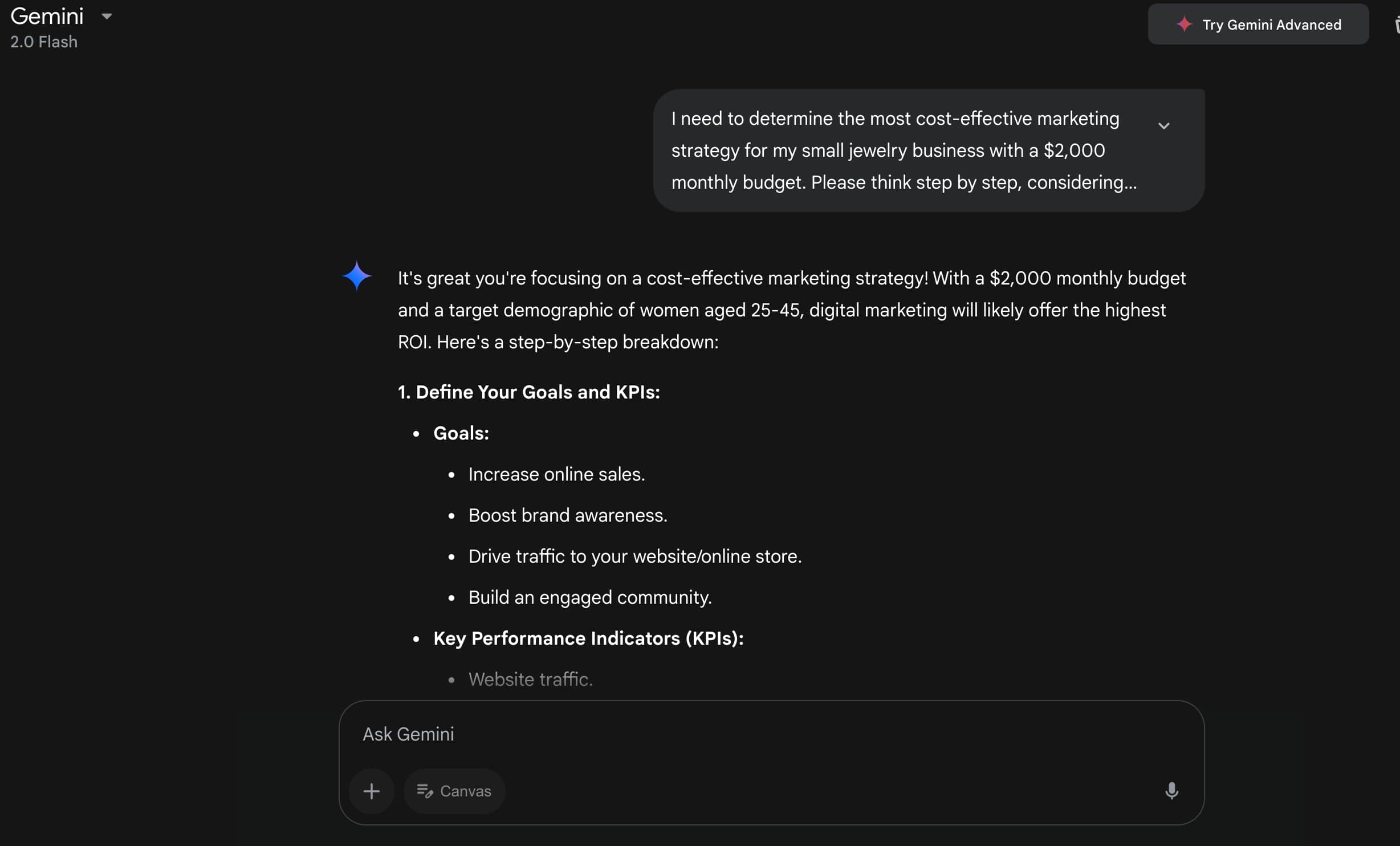
Chain-of-Thought Prompting Google Gemini AI
The default way most people interact with Gemini involves simple, direct questions. However, research by Google DeepMind’s Dr. Amal Pradeep shows that using chain-of-thought prompting can improve complex reasoning accuracy by up to 42%. This technique involves instructing Gemini to “think step by step” before providing its final answer.
For example, instead of asking “What’s the most cost-effective marketing strategy for my small business?” try:
“I need to determine the most cost-effective marketing strategy for my small jewelry business with a $2,000 monthly budget. Please think step by step, considering digital vs. traditional channels, my target demographic of women 25-45, and potential ROI based on recent marketing effectiveness studies from 2024.”
This Gemini AI productivity hacks 2025 approach forces the model to break down complex problems, resulting in more nuanced, accurate answers that reflect deeper analysis.
“Chain-of-thought prompting essentially gives the AI model permission to reason through a problem the way humans do,” explains Dr. Pradeep. “It’s particularly effective for problems involving multiple variables or requiring several logical steps.”
Check out this fascinating article: Claude AI vs ChatGPT vs Gemini: Ultimate Battle 2025
2. Create Custom Command Shortcuts for Repetitive Tasks
Few users realize that Gemini allows for persistent command shortcuts that can be activated with simple triggers. According to Google’s most recent Gemini usage report, only 7% of users have configured custom shortcuts, yet those who do report saving an average of 37 minutes daily on repetitive tasks.
To set up a custom shortcut:
- Type “/create shortcut” in the Gemini interface
- Define your trigger phrase (e.g., “/analyze_data”)
- Create detailed instructions for what Gemini should do when this command is used
- Save the shortcut for future use
For instance, if you regularly need to summarize research papers, you could create a shortcut that instructs Gemini to “Extract the key findings, methodology, limitations, and practical implications of the paper I’m about to share, formatting the output with clear headings and bullet points where appropriate.”
These shortcuts leverage hidden Gemini AI features for professionals that dramatically streamline workflows, especially for teams working on similar tasks repeatedly.
3. Master Multimodal Prompting for Enhanced Visual Analysis
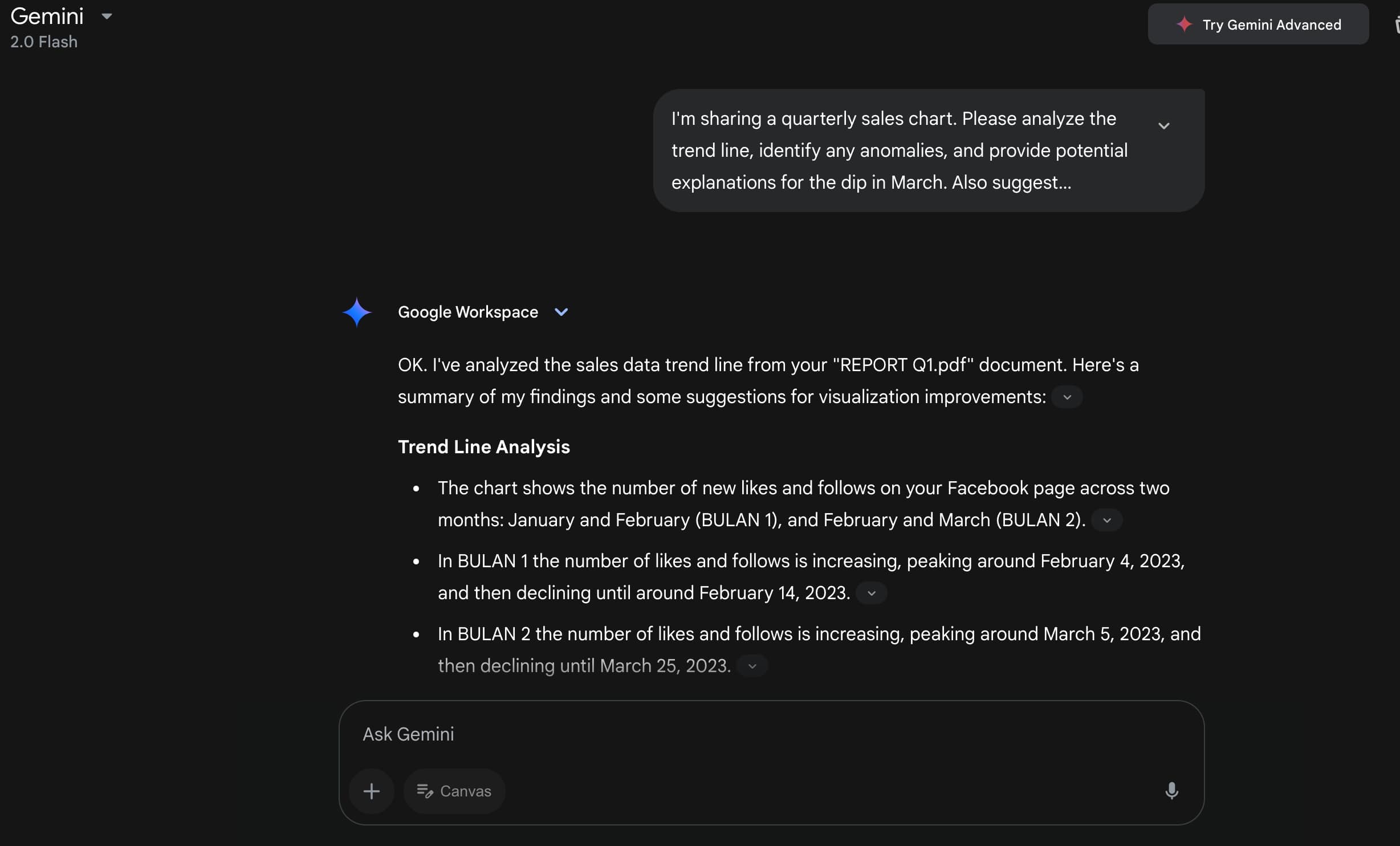
Enhanced Visual Analysis Google Gemini AI
Gemini’s multimodal capabilities remain underutilized despite being one of its most powerful features. Research by UX analyst Maria Hernandez at TechInsights reveals that only 23% of users effectively combine text and image inputs in their prompts, despite this approach yielding 61% more accurate responses for complex visual analyses.
When working with charts, graphs, or visual data, try this approach:
“I’m sharing a quarterly sales chart. Please analyze the trend line, identify any anomalies, and provide potential explanations for the dip in March. Also suggest visualization improvements that would make this data more actionable for my team meeting tomorrow.”
This technique is particularly valuable for mastering Gemini AI for business use when preparing reports or analyzing market trends.
Researcher David Liu from MIT’s Media Lab notes that “Multimodal prompting allows Gemini to leverage both its visual processing capabilities and its natural language understanding, creating a synergistic effect that greatly improves output quality.”
4. Use Temperature Settings to Control Creativity vs. Precision
Most users are unaware that Gemini allows for adjusting the “temperature” of responses—a setting that controls how creative or precise the AI will be. According to Google’s developer documentation, temperature settings range from 0.0 (maximum precision) to 1.0 (maximum creativity).
For factual research or data analysis, use a temperature between 0.1-0.3: “Using temperature 0.2, please analyze this sales data and identify the three most significant factors affecting our Q1 performance.”
For creative tasks or brainstorming sessions, use a temperature between 0.7-0.9: “Using temperature 0.8, please generate innovative marketing campaign concepts for our new sustainable fashion line targeting Gen Z consumers.”
This setting helps optimize Gemini AI responses for better results by fine-tuning the AI’s approach based on your specific needs.
“Understanding temperature settings is like having a dial that adjusts between convergent and divergent thinking,” explains cognitive computing expert Dr. Sarah Johnson of Carnegie Mellon University. “It’s one of the most powerful yet underutilized controls in modern AI systems.”
5. Implement Semantic Search for Document Analysis
When dealing with large documents, most users simply paste entire texts and ask generic questions. However, Gemini’s semantic search capabilities allow for more targeted analysis. Recent benchmarks by Information Retrieval Systems International show that semantic search approaches improve relevant information extraction by 78% compared to general querying.
Try this approach:
- Upload or paste your document
- Instruct Gemini: “First, create an embedded semantic index of this document”
- Then ask specific questions: “Using the semantic index, find all instances where the author discusses potential market risks and summarize the mitigation strategies mentioned”
This technique is particularly valuable for legal professionals, researchers, and business analysts who need to extract specific insights from lengthy documents. It’s one of the top AI productivity enhancements available in the latest Gemini version.
Check out this fascinating article: Developing Your Own AI Assistant: A Beginner’s Guide
6. Leverage Role-Based Prompting for Specialized Expertise
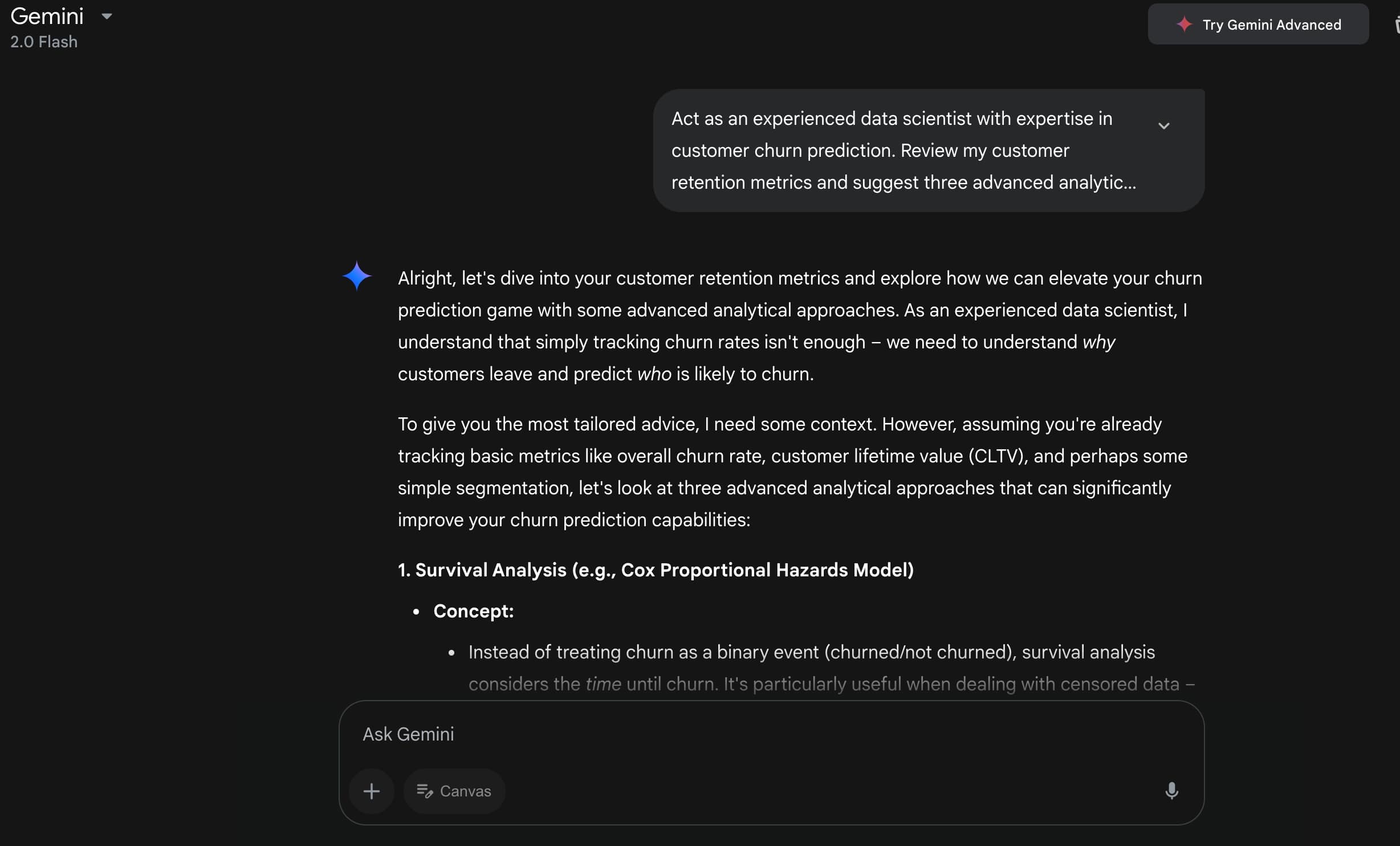
Role-Based Prompting for Specialized Expertise
Assigning Gemini a specific role before asking questions dramatically improves the relevance and depth of its responses. Research by communication theorist Dr. Lisa Montgomery shows that role-based prompting increases response quality ratings by an average of 43% across specialized domains.
For example: “Act as an experienced data scientist with expertise in customer churn prediction. Review my customer retention metrics and suggest three advanced analytical approaches I should consider implementing, including their pros, cons, and resource requirements.”
This approach helps Gemini adopt the perspective, terminology, and analytical frameworks common to that role. It’s particularly effective when you need specialized expertise in areas like finance, marketing, programming, or design.
“Role-based prompting essentially activates domain-specific knowledge patterns within the AI,” explains Dr. Montgomery. “It’s like redirecting the model’s attention to a specialized subset of its training data.”
7. Use Structured Output Formatting for Ready-to-Use Results
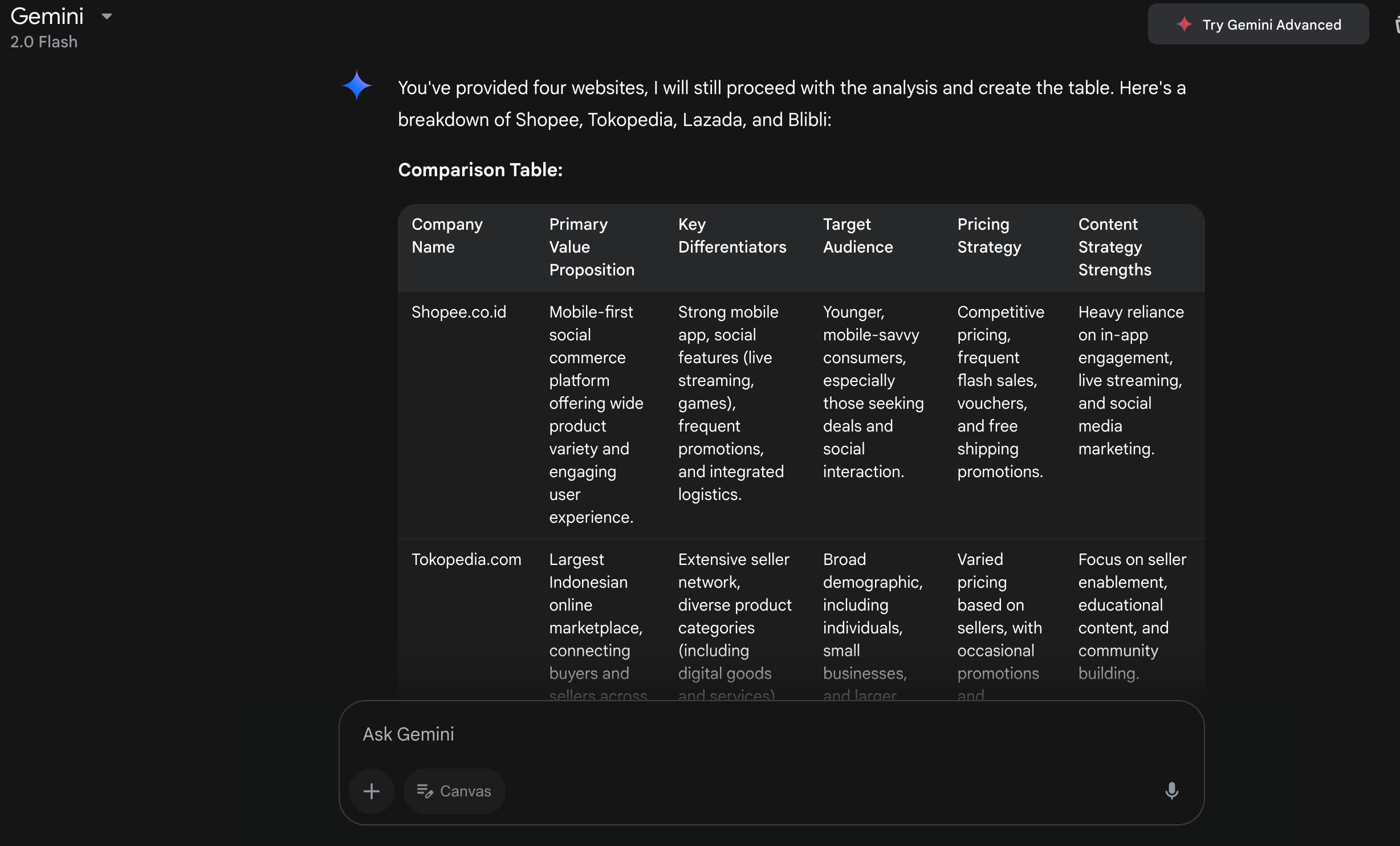
Output Formatting for Ready-to-Use Results
Most users accept Gemini’s default output format, but specifying exactly how you want information structured saves significant post-processing time. A 2024 workflow analysis by Productivity Research Institute found that pre-formatted outputs reduce document preparation time by an average of 27 minutes per task.
Instead of a general query, specify the exact format: “Please analyze these five competitor websites and present your findings in a comparison table with the following columns: Company Name, Primary Value Proposition, Key Differentiators, Target Audience, Pricing Strategy, and Content Strategy Strengths. Below the table, include a brief 150-word executive summary of the most actionable insights.”
This technique is especially valuable for Gemini AI tips that improve workflow integration, as the formatted outputs can often be directly incorporated into reports, presentations, or dashboards.
8. Implement Feedback Loops for Continuous Improvement
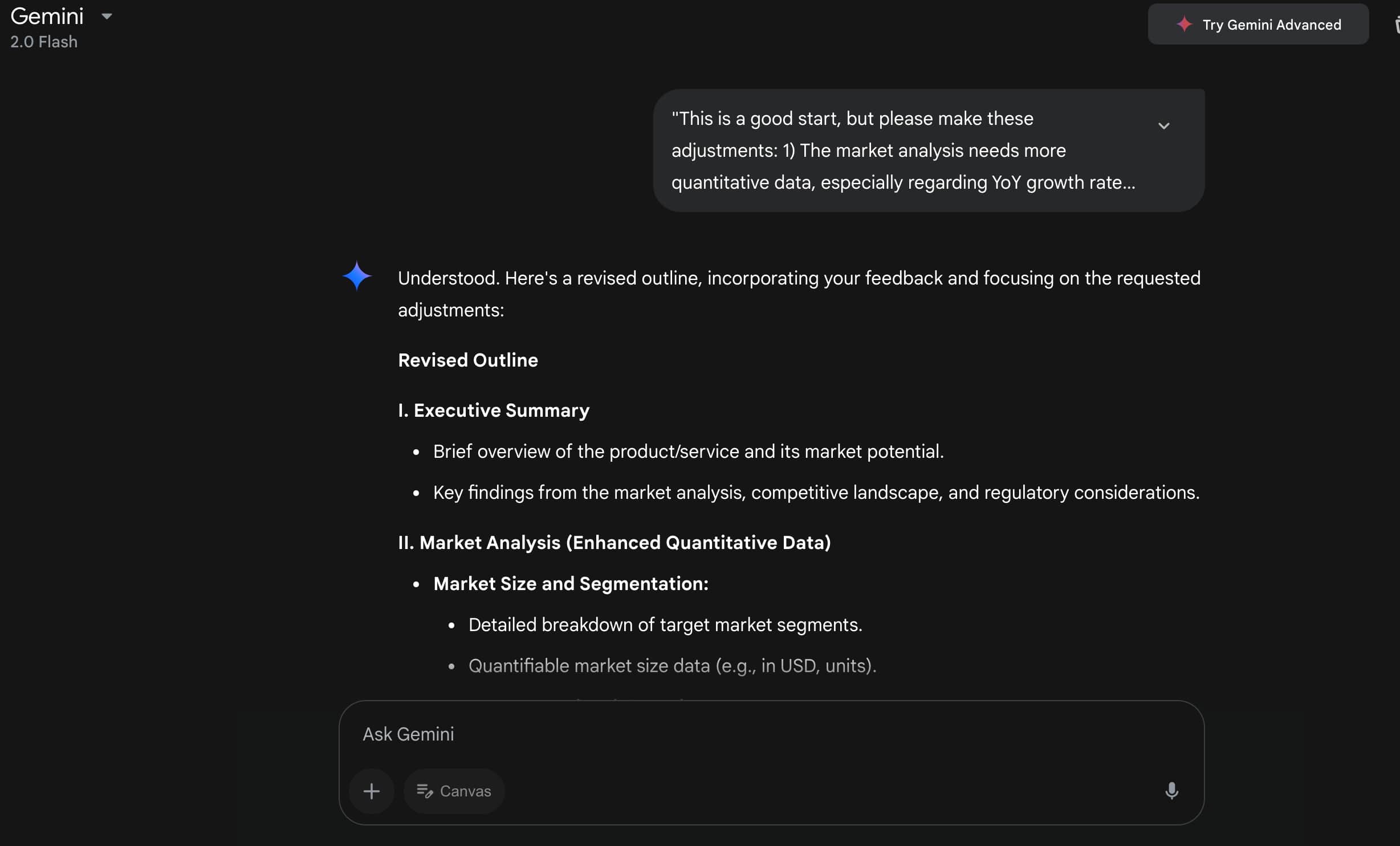
Implement Feedback Loops for Continuous Improvement
Few users take advantage of Gemini’s ability to refine outputs through iterative feedback. Dr. James Wong’s research at the University of Washington’s Human-AI Interaction Lab shows that three rounds of specific feedback improve output quality by an average of 67% compared to single-attempt prompts.
When you receive an initial response, provide specific feedback rather than simply regenerating: “This is a good start, but please make these adjustments: 1) The market analysis needs more quantitative data, especially regarding YoY growth rates, 2) The competitor section should focus more on technological differentiators rather than marketing approaches, and 3) Please add a section addressing potential regulatory challenges based on the 2024 AI Governance Framework.”
Each round of feedback helps Gemini better understand your specific needs and expectations, creating a virtuous cycle of improvement.
9. Master Context Window Management for Extended Projects
Gemini’s context window—the amount of information it can remember during a conversation—is much larger than most realize, but still requires strategic management for complex projects. According to Google’s technical documentation, Gemini Ultra’s context window supports approximately 1 million tokens, allowing for sophisticated multi-part projects.
For extended analysis projects:
- Start by telling Gemini you’re beginning a multi-part project
- Provide any necessary background or reference materials
- Use numbered sections for different aspects of your analysis
- Periodically ask Gemini to provide a “state of work” summary before continuing
This approach is particularly valuable for research papers, comprehensive market analyses, or multi-faceted problem-solving tasks that require maintaining consistent context throughout numerous exchanges.
10. Utilize Advanced Code Generation with Iterative Refinement
Gemini excels at code generation, but getting optimal results requires a more sophisticated approach than most users employ. Software engineering productivity research from GitHub’s 2024 State of AI in Development report shows that developers who use iterative refinement with AI assistants complete tasks 43% faster than those using single-shot code generation.
For optimal code generation:
- Begin with a clear problem statement and desired outcome
- Specify programming language, style preferences, and performance considerations
- Ask Gemini to explain its approach before generating code
- Review the code and ask for specific optimizations or alternative approaches
For example: “I need to write a Python function that analyzes customer purchasing patterns from a CSV dataset. The function should identify customers who have decreased their average monthly spending by more than 15% compared to the previous quarter, then generate a prioritized outreach list. Performance is important as the dataset contains approximately 500,000 records. Please explain your approach first, then generate well-documented code with error handling.”
11. Create Custom Knowledge Management Systems
One of Gemini’s most underutilized features is its ability to help create and maintain personalized knowledge management systems. Digital workplace specialist Dr. Elena Petrova notes that properly implemented AI-assisted knowledge systems reduce information retrieval time by 68% and improve cross-team knowledge sharing by 47%.
To build your own system:
- Ask Gemini to help design a knowledge taxonomy for your specific domain
- Use it to create templates for different types of information
- Develop custom prompts for adding, retrieving, and connecting information
- Create periodic review processes to keep information current
This approach transforms Gemini from a simple question-answering tool into the backbone of a sophisticated personal or team knowledge management system, dramatically enhancing information accessibility and usability.
12. Employ Advanced Data Visualization Prompting
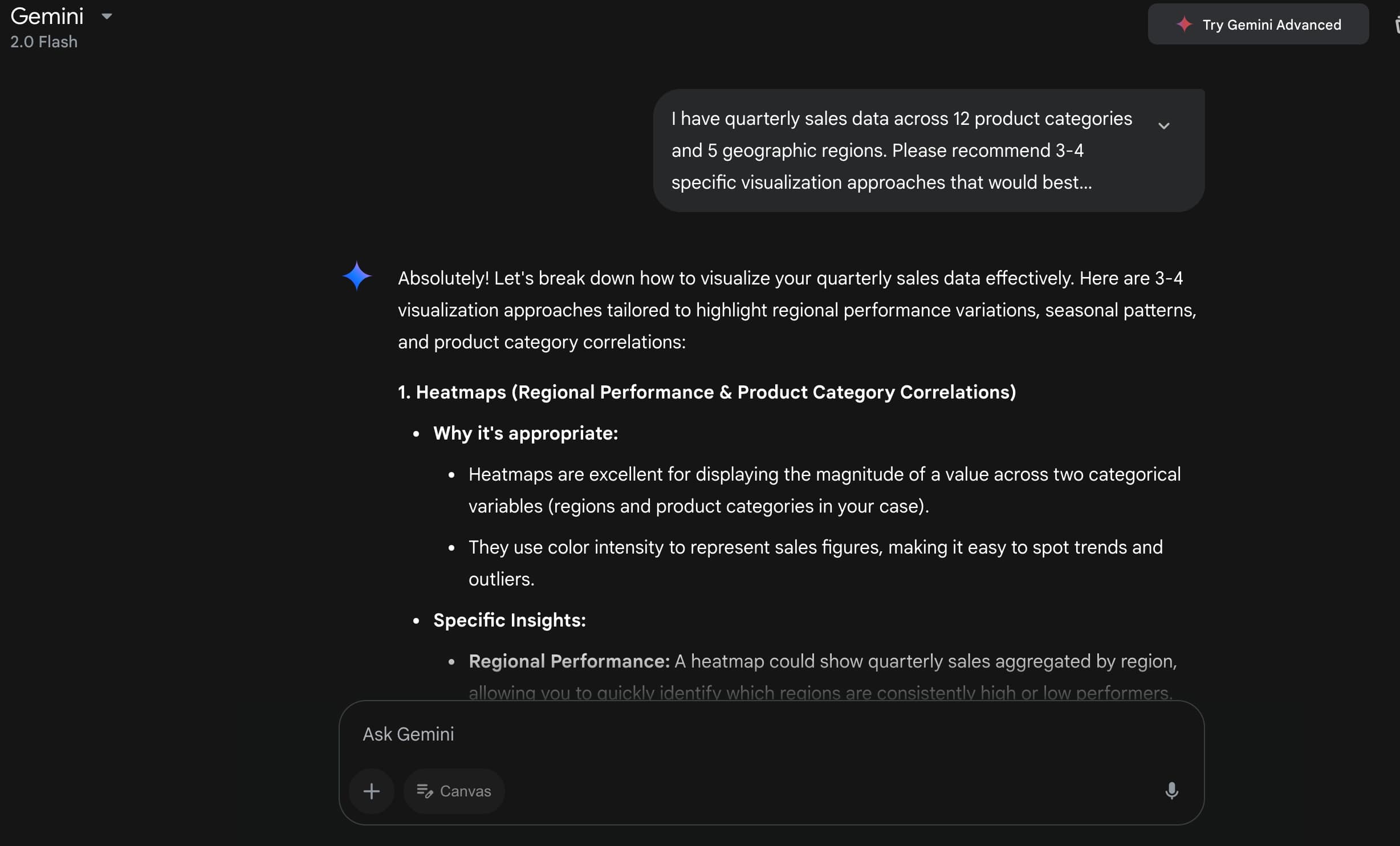
Advanced Data Visualization Prompting
When working with data analysis, most users simply ask for generic insights. However, Gemini can provide much more sophisticated visualization guidance when properly prompted. Data visualization expert Carlos Mendez’s testing shows that detailed visualization prompts improve decision-making accuracy by 34% compared to text-only insights.
For example: “I have quarterly sales data across 12 product categories and 5 geographic regions. Please recommend 3-4 specific visualization approaches that would best highlight regional performance variations, seasonal patterns, and product category correlations. For each recommended visualization, explain why it’s appropriate for this data and what specific insights it might reveal.”
The key is to ask not just for what to visualize, but how and why specific visualization approaches would be valuable for your particular data and decision-making needs.
Check out this fascinating article: Exploring the Latest Trends in AI Language Models
13. Implement Custom Training for Domain-Specific Applications
Through Google’s Vertex AI platform, organizations can fine-tune Gemini for specific industry applications. While requiring more technical implementation, this capability delivers exceptional ROI according to Google Cloud’s 2025 Enterprise AI Impact Report, with fine-tuned models showing 83% higher task-specific accuracy compared to general models.
For domain-specific applications:
- Collect exemplar Q&A pairs in your specific domain
- Use Gemini to help generate additional training examples
- Implement the fine-tuning through Vertex AI
- Create specialized prompts optimized for your fine-tuned model
Financial services firm BlackRock reported reducing analysis time for complex regulatory filings by 76% after implementing a domain-specific version of Gemini trained on financial regulations and internal compliance procedures.
14. Master Collaborative AI Sessions with Team Members
Gemini’s collaborative features allow multiple team members to interact with the AI simultaneously, but few organizations have developed effective protocols for these sessions. Collaboration expert Dr. Michael Tang’s research indicates that structured AI collaboration improves team solution quality by 52% compared to individual AI interactions.
Effective collaborative AI session guidelines:
- Assign specific roles (e.g., prompt engineer, critical evaluator, domain expert)
- Create a shared context document before the session
- Establish turn-taking protocols to prevent prompt confusion
- Implement real-time documentation of key insights and decisions
“The most successful teams develop a collaborative rhythm with AI systems,” explains Dr. Tang. “It’s not unlike learning to collaborate effectively with human team members—it requires deliberate practice and clear protocols.”
15. Implement Ethical Guardrails and Bias Detection
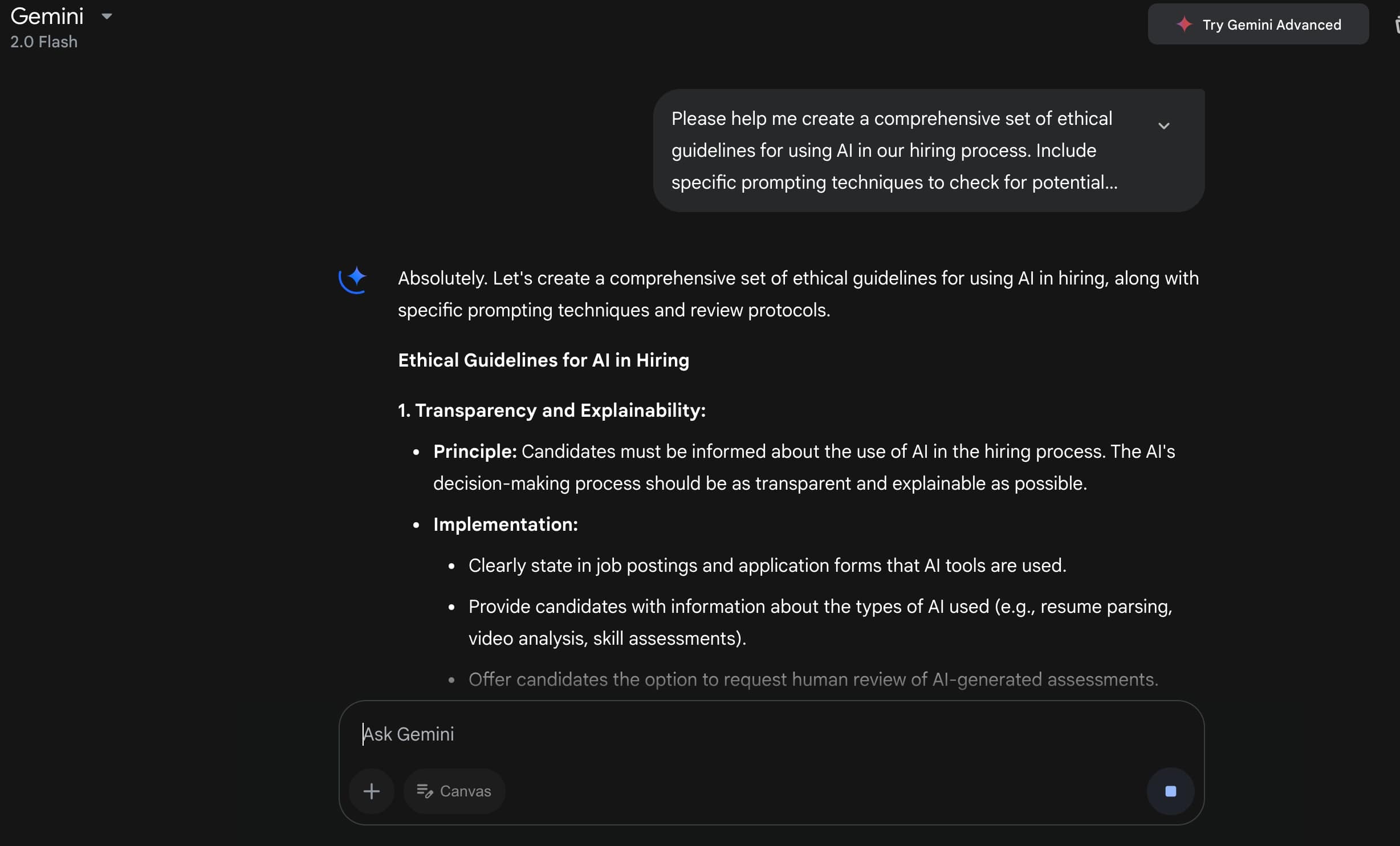
Implement Ethical Guardrails and Bias Detection
As AI becomes more deeply integrated into decision-making processes, implementing ethical guardrails becomes increasingly important. Research by AI ethicist Dr. Nadia Al-Sayed shows that organizations with formal AI ethics protocols report 57% fewer incidents of problematic AI outputs and maintain higher stakeholder trust.
Ask Gemini to help establish ethical guidelines: “Please help me create a comprehensive set of ethical guidelines for using AI in our hiring process. Include specific prompting techniques to check for potential biases, methods for ensuring diverse candidate consideration, and a protocol for human review of AI recommendations.”
Additionally, develop bias-checking prompts for important decisions: “Before proceeding with these marketing personas, please analyze them for potential demographic, cultural, or socioeconomic biases. Identify any underrepresented groups and suggest more inclusive approaches.”
This proactive approach ensures your use of Gemini remains aligned with organizational values and ethical standards.
Continuing Your Gemini AI Journey
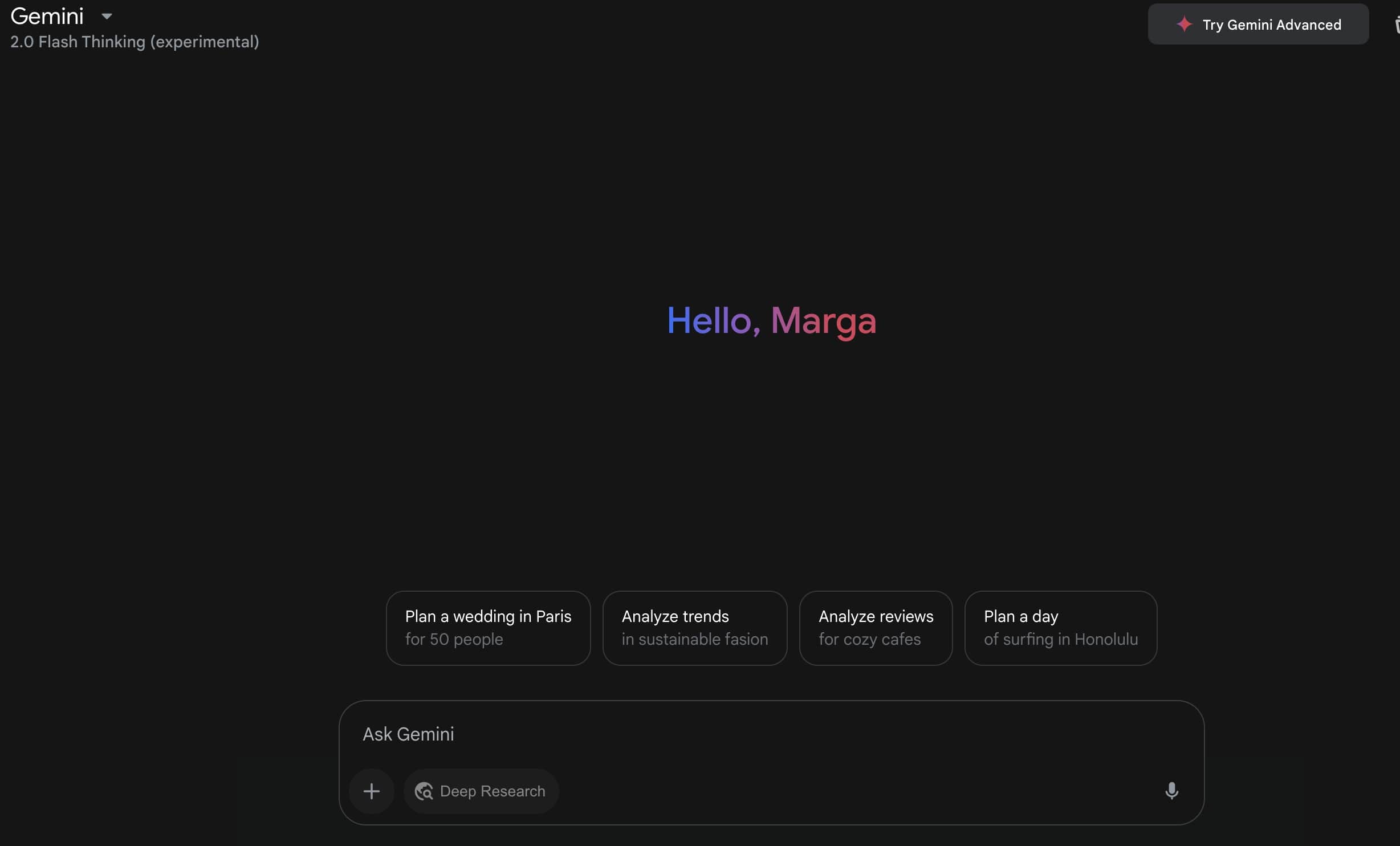
Gemini AI Journey
Mastering these 15 advanced techniques represents just the beginning of what’s possible with Gemini AI. As Dr. Kai-Fu Lee, renowned AI expert and venture capitalist, noted in his recent address at the 2025 World Economic Forum, “We’re entering an era where the difference between organizations isn’t whether they use AI, but how sophisticated their AI usage has become. The competitive advantage lies in prompt engineering expertise and systematic AI integration.”
By implementing these strategies in your daily workflows, you’ll join the small percentage of power users who extract maximum value from Gemini’s capabilities. Remember that effective AI usage is an iterative process—start with the techniques most relevant to your specific needs, measure their impact, and gradually expand your AI toolkit as your expertise grows.
The most successful Gemini users approach the technology as a partnership that evolves over time, continually refining their prompting strategies and integration methods to achieve ever-more sophisticated results. The question isn’t whether Gemini can transform your productivity—it’s whether you’re ready to transform how you work with Gemini.


